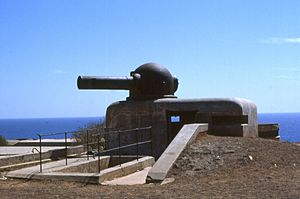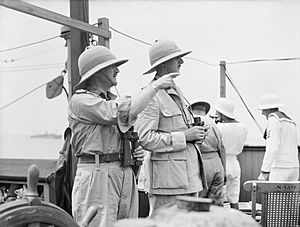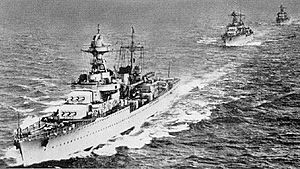Battle of Dakar facts for kids
The Battle of Dakar, also known as Operation Menace, was an attempt by the Allies in September 1940 to take control of the important port city of Dakar. Dakar is in French West Africa, which is now Senegal.
The Allies hoped that if they succeeded, the government in Dakar, which supported Vichy France (a French government that worked with Germany), would be replaced by a government loyal to the Free French Forces. These forces were led by General Charles de Gaulle and fought against Germany.
Quick facts for kids Battle of Dakar |
|||||||
|---|---|---|---|---|---|---|---|
| Part of World War II | |||||||
|
|||||||
| Belligerents | |||||||
|
|||||||
| Commanders and leaders | |||||||
| Strength | |||||||
|
|
||||||
| Casualties and losses | |||||||
| 2 battleships damaged 2 cruisers damaged 6 torpedo planes lost |
1 destroyer grounded 2 submarines sunk 1 battleship damaged Danish freighter MS Tacoma sunk 100 dead 182 wounded 84 civilians dead 197 civilians wounded |
||||||
Contents
Why Dakar Was Important
After France was defeated by Nazi Germany in June 1940, there was a lot of confusion. No one was sure which side many French colonies would support. Some colonies, like Cameroon, joined the Free French. But others, including French West Africa where Dakar is, stayed loyal to Vichy France.
The British worried that the French navy might fall under German control. Because of this, the British attacked the French fleet at Mers-el-Kebir in July 1940. This attack removed a possible threat, but it also made some French forces less likely to join the Allies.
General de Gaulle believed he could convince the French forces in Dakar to join the Allies. Taking Dakar would be a big win for several reasons:
- It would show that another Vichy French colony had switched sides, which would be a huge political victory.
- Important gold reserves from the Bank of France were stored in Dakar.
- Dakar had a much better naval base than Freetown in British Sierra Leone, which was the only Allied port nearby.
So, the Allies sent a large group of ships and troops to Dakar. This group included an aircraft carrier (HMS Ark Royal), two battleships (HMS Resolution and HMS Barham), five cruisers, ten destroyers, and ships carrying 8,000 soldiers. Their orders were to try and negotiate a peaceful takeover of Dakar. If that didn't work, they were to take the city by force.
The Vichy French forces in Dakar had their own strong ships. These included the battleship Richelieu, which was almost finished being built and was one of France's most modern warships. It had left France just before the Germans arrived.
Before the Vichy government took power, a British aircraft carrier, HMS Hermes, was working with French forces in Dakar. But once Vichy France was in charge, Hermes left the port. It stayed nearby and was joined by the Australian heavy cruiser HMAS Australia. Aircraft from Hermes attacked Richelieu with a torpedo, damaging it. The Richelieu was stuck but could still use its powerful guns.
A few days before the Allied fleet arrived, three French cruisers (Gloire, Georges Leygues, and Montcalm) and three destroyers left Toulon, France, heading for Dakar. Gloire had engine problems and was stopped by HMAS Australia, which ordered it to go to Casablanca. The other two cruisers and the destroyers managed to escape the Allied ships and reached Dakar safely. Three Vichy submarines and other smaller ships were also in Dakar.
The Battle Begins
On September 23, British planes dropped leaflets with messages on Dakar. Then, three Free French officers tried to land at the airport, but they were immediately captured. A list of Free French supporters in Dakar was found on one of them, and the Vichy authorities quickly arrested those people.
A boat carrying representatives of de Gaulle tried to enter the port but was fired upon. British planes were also shot at by anti-aircraft guns from the Richelieu and a French fighter plane.
At 10:00 AM, Vichy ships tried to leave the port, but HMAS Australia fired warning shots. As these ships returned to port, Vichy coastal guns opened fire on Australia. These powerful guns had a range of 14 kilometers. A fight between the Allied fleet and the coastal guns lasted for several hours.
In the afternoon, HMAS Australia attacked the Vichy destroyer L'Audacieux, setting it on fire. The destroyer had to be beached (run aground on the shore).
Later that day, Free French troops tried to land on a beach southeast of Dakar. However, Vichy planes spotted them. Due to fog and heavy fire from strong defenses on the beach, the landing failed. General de Gaulle decided not to continue the attack, saying he didn't want to "shed the blood of Frenchmen for Frenchmen."
Fighting Continues
For the next two days, the Allied fleet kept attacking the coastal defenses, and the Vichy forces kept fighting back.
On September 24, British planes tried to bomb the Richelieu and the coastal guns, but they caused little damage. During these air attacks, several British planes were shot down by anti-aircraft fire and by French Curtiss Hawk fighter planes. In one attack, 4 out of 9 British aircrew were killed. French planes often attacked British aircraft whenever they tried to scout or attack.
The battleship Richelieu was hit by two large 15-inch shells from the British battleship Barham. The Richelieu's main guns also had problems, but they fired 24 rounds in total over two days. One of these shots might have been a near miss on Barham.
During these battles, two Vichy submarines, Persée and Ajax, were sunk. The destroyer L'Audacieux was badly damaged.
The Allied fleet also suffered damage. The battleship Resolution was hit by a torpedo from the Vichy submarine Bévéziers. The battleship Barham was hit by two shells from the coastal guns. Barham also had some damage from a near miss by a 380mm round from Richelieu. The cruisers HMAS Australia and HMS Cumberland were also damaged. On the last day, more air battles happened, with the French Curtiss Hawks generally being better than the British planes.
What Happened Next
The Battle of Dakar was not a success for the Allies. The Vichy forces did not give up. The battleship Resolution was so badly damaged that it had to be towed all the way to Cape Town for repairs.
During this time, Vichy French planes from North Africa bombed the British base at Gibraltar. On September 24, about 50 planes dropped 150 bombs. On September 25, about 100 planes dropped 300 bombs on the harbor. Most of the bombs missed, but some damage was done, and a few civilians were killed. A British armed trawler, HMT Stella Sirius, was also sunk.
In the end, the Allies left Dakar. French West Africa remained under Vichy control.
The failure at Dakar had a big impact on politics. De Gaulle had thought he could convince the Vichy French in Dakar to switch sides, but he was wrong. This made him look less strong among the Allies. Even though he had a success in the Battle of Gabon two months later, it didn't fully fix the damage. For a while, he had to be content with the less important French Equatorial Africa as the main Free French territory.
The English writer Evelyn Waugh was part of this expedition as an officer. The battle is mentioned in his book Men at Arms.
Ships Involved in the Battle
Allied Forces
- Aircraft carrier: Ark Royal
- Battleships: Barham, Resolution
- Heavy cruisers: Australia, Cumberland, Devonshire
- Light cruisers: Dragon, Delhi
- Destroyers: Echo, Eclipse, Escapade, Faulknor, Foresight, Forester, Fortune, Fury, Griffin, Greyhound, Inglefield
- Escorts/patrol boats: Bridgewater, Commandant Dominé, Commandant Duboc, Président Houduce, Milford, Savorgnan de Brazza
- Merchant ships: four Free French and one British
- Transports: Pennland and Westernland (Dutch ocean liners), Sobieski (Polish ocean liner) and three more
- Soldiers: 101st Royal Marine Brigade
Vichy French Forces
- Battleship: Richelieu
- Light cruisers: Georges Leygues, Montcalm
- Destroyers: L'Audacieux, Le Fantasque, Le Malin, Le Hardi
- Escorts/patrol boats: Calais, Commandant Rivière, D'Entrecasteaux, D'Iberville, Gazelle, Surprise
- Auxiliary cruisers (armed merchant ships): El Djezair, El Kantara, El Mansour, Schoelcher, Ville d'Oran
- Merchant ships: Porthos, Tacoma, Sally Maersk (Danish freighter)
- Submarines: Ajax, Bévéziers, Persée
See also





